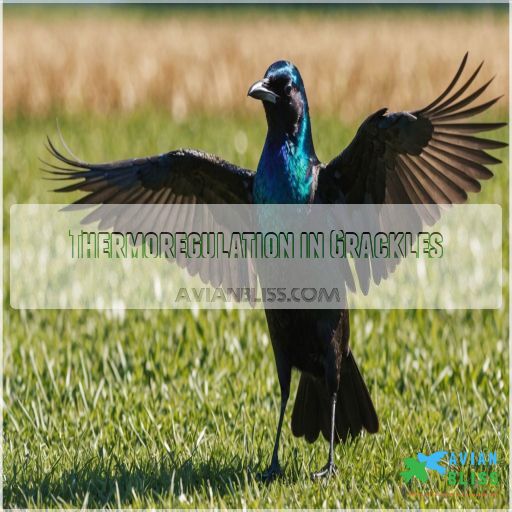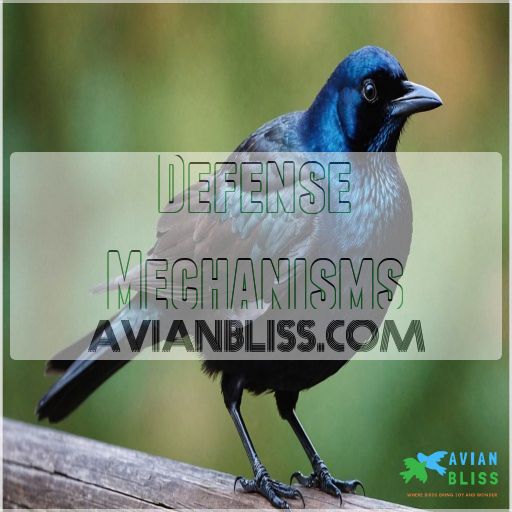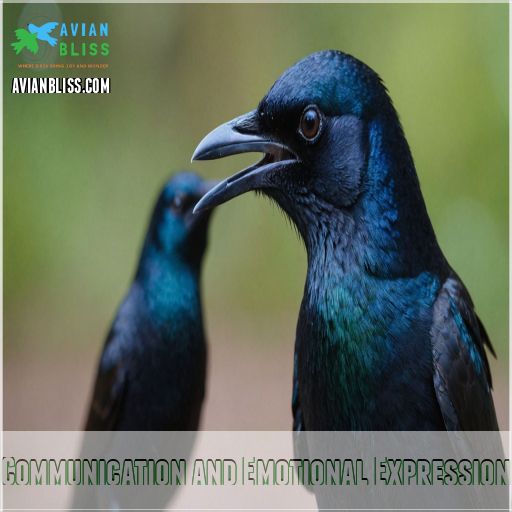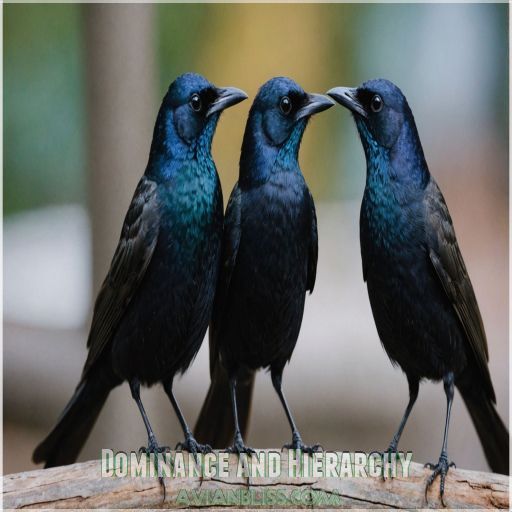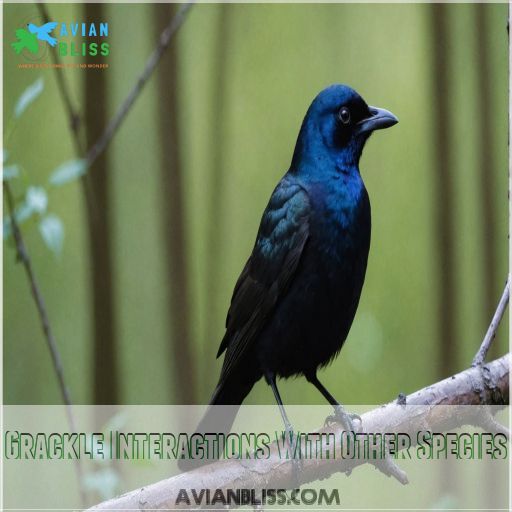This site is supported by our readers. We may earn a commission, at no cost to you, if you purchase through links.
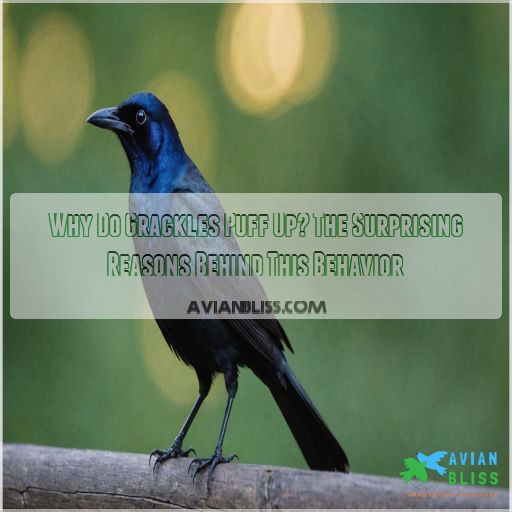
Puffing up plays into their social hierarchy and even their love life; it’s a full-on display for attracting mates. Picture grackles donning their puffiest jackets in winter or performing a dramatic act on stage.
Want to learn how this behavior ties into their broader communication skills? You’ve come to the right spot!
Table Of Contents
- Key Takeaways
- Grackle Social Behavior
- Thermoregulation in Grackles
- Mating Rituals and Displays
- Defense Mechanisms
- Communication and Emotional Expression
- Dominance and Hierarchy
- Grackle Interactions With Other Species
- Environmental and Diet Impact
- Managing Grackles in Human Spaces
- Frequently Asked Questions (FAQs)
- Why do grackles puff up?
- What causes punching in sleep?
- Why do grackles stick out their chest?
- Why do grackles tilt their beaks?
- What does it mean when grackles puff up?
- Are grackles good birds to have around?
- Why do grackles hold their heads up?
- What does it mean when a bird puffs up?
- What illnesses affect grackle populations significantly?
- How do grackles adapt to urban environments?
- What sounds do grackles make during courtship?
- Why are grackles often mistaken for crows?
- Do grackles pose a threat to domestic poultry?
- Conclusion
Key Takeaways
- Grackles puff up their feathers to regulate their body temperature, trapping warm air and conserving energy, just as you would bundle up in a cozy jacket on a chilly day.
- Puffing up is a key part of grackle courtship rituals, as the males put on an impressive display to attract mates with their dramatic bill tilts, wing spreading, and mating calls. It’s nature’s version of a feathery dance-off!
- Grackles puff up to appear larger and more intimidating, using this as a defense mechanism to scare off predators and protect their personal space. It’s their clever way of saying, "back off!"
- Puffing up is a form of visual communication for grackles, allowing them to express a range of emotions, from excitement to aggression, as they navigate their complex social hierarchies. Pay close attention to signs of affection in birds, and you’ll decode their feathery body language like a parakeet behavior guide
!
Grackle Social Behavior
When you observe grackles, you might notice their fascinating social behavior. As social creatures, they often form large flocks, exhibiting complex group dynamics and species coordination.
Within these flocks, grackles engage in dominance displays, puffing up to assert their dominance and establish social order . This behavior is key in maintaining their social hierarchy, which is important for their survival and mating rituals.
By studying grackle social behavior, you can gain insight into their communication and emotional expression, as well as their interactions with other species. As you watch these birds, remember that their social interactions are just as intriguing as their distinctive calls and iridescent feathers.
Thermoregulation in Grackles
Ever wonder why grackles puff up on chilly mornings?
It’s their clever way of creating a cozy air layer between their feathers to keep warm and conserve energy.
Like us reaching for that fluffy sweater when it’s cold out.
How Puffing Up Retains Heat
As you observe grackles, notice how they puff out their feathers to regulate their body temperature.
This clever tactic, known as thermoregulation, allows them to trap warm air next to their skin, effectively retaining heat.
By fluffing their feathers, grackles create a layer of insulation, reducing heat loss and maintaining a cozy body temperature, much like wearing a warm, fuzzy jacket on a chilly day, which is similar to the effect of wearing a warm, fuzzy jacket. This behavior showcases the birds’ ability to adapt and stay comfortable, making use of their layer of insulation.
Energy Conservation Strategies
Imagine battling chilly winds with just a jacket made of feathers! Grackles puff up their plumage for warmth. This clever tactic fights energy loss while ensuring several benefits.
- Feather insulation
- Winter survival
- Reduced energy expenditure
- Smart nest building
- Species variability adaptation
So, next time you see a puffed-up grackle, tip your hat to its cozy, energy-saving strategy!
Mating Rituals and Displays
When you’re watching grackles strutting their stuff, you’re seeing nature’s version of a flashy dance-off.
These bold displays aren’t just for show—they’re grackle-style love letters, helping them find and woo a mate.
Courtship Behavior
Grackles’ puffing displays aren’t just for warmth; they’re part of charming courtship rituals.
Imagine this: a male grackle performing the bill tilt ritual, wing spreading, tail flaring, and dramatic mating calls.
These moves establish dominance and communicate territorial behavior signals
. It’s like a feathery Romeo wooing Juliet!
Despite aggressive behaviors, courtship often remains a peaceful ritual.
| Behavior | Purpose | Observation Level |
|---|---|---|
| Bill Tilt | Display interest | High |
| Wing Spreading | Attract attention | Moderate |
| Tail Flaring | Assert dominance | High |
| Mating Calls | Communicate presence | High |
Attracting Mates With Display
You’ll see male grackles performing impressive displays to attract mates.
They’re masters at strutting their stuff with:
- Bill-tilt rituals: Pointing their beaks skyward majestically.
- Plumage displays: Flaunting their iridescent feathers.
- Vocalizations: Serenading with unique melodies.
- Mating dance: Moving rhythmically to impress female grackles.
It’s a real-life avian dance-off!
Defense Mechanisms
Ever wondered why grackles puff up like tiny feathered balloons?
They’re not just showing off; they’re actually making themselves look bigger to scare off predators.
They’re also doing this to maintain their personal bubble.
Intimidating Predators
Grackles puff up their feathers to appear larger and more intimidating to potential predators.
This defense mechanism makes them look more threatening, deterring attacks from hawks, owls, or other birds of prey.
By fluffing out their feathers, grackles can make themselves seem too big for a predator to take on (Source). It’s an effective way for these clever birds to avoid becoming someone else’s dinner.
They use this method for avoiding attacks and potential predators.
Protecting Personal Space
Imagine you’re a common grackle, cozy in your personal bubble. Suddenly, another bird invades, like an unwanted guest at a party. What do you do? You puff up! This isn’t just bird aggression—it’s a clever social distancing trick.
Puffing acts as a deterrent, signaling, "Back off!" It’s classic territory defense, complete with a dramatic grackle call—the ultimate avian "Keep Out" sign.
This puffed-up defense mechanism isn’t unique to grackles and is often seen in birds like parrots, who puff up to appear larger and more intimidating to potential threats. By puffed up their feathers, birds can create a sense of personal space and protect themselves from unwanted interactions.
Communication and Emotional Expression
Ever wondered why grackles look like little feathered puffballs sometimes?
It turns out they’re doing more than just flaring their feathers—they’re actually using body language to chat and express their feelings, just like you might wave your arms around when you’re excited or upset.
Non-Verbal Signals
When you’re observing grackles, their puffing behavior acts as a fascinating form of visual display.
This body language serves as potent communication cues in their social signaling—especially during courtship rituals.
Male grackles often puff up to attract mates or assert dominance. It’s their feathered announcement: “Hey, notice me or stay away!”
This communication is a dynamic mix of style and substance, and can be seen as a way of saying "Hey, notice me or stay away!
Emotional States Indicated by Puffing
Spotting a puffed-up grackle, you might think it’s striking a pose, but it’s actually communicating.
This behavior can indicate various emotional states:
- Puffing and anxiety: Like wearing armor, it protects against perceived threats.
- Fear and puffing: Shows vulnerability, just like us clutching a comforting blanket.
- Puffing and excitement: Celebrates triumphs, even small ones.
- Puffing and aggression: Warns rivals to back off.
Engage with these nuanced behaviors to understand grackles better.
Dominance and Hierarchy
Ever wonder why grackles puff up and strut around like they’re on a mission?
It’s all about showing who’s boss and keeping the social pecking order straight.
Like when your friend takes the front seat and claims it’s their permanent spot, it’s about establishing a sense of permanent spot.
Establishing Social Order
Grackles aren’t just puffing up to communicate emotions, they’re orchestrating complex social signaling.
Establishing social order through puffing rituals helps grackles navigate dominance hierarchies. It’s like avian politics at play.
Those dramatic displays aren’t all show—they subtly establish who’s who in group dynamics, often preventing territorial disputes before they start. Grackles know the art of non-verbal negotiations.
Challenges Among Males
Amidst the bustling grackle colony, males engage in fierce mating competition.
They vie for prime territories, squawking and puffing up their feathers in aggressive displays to assert dominance.
The "bill tilt" ritual, where they tilt their heads back and open their beaks, is a key part of this dominance hierarchy.
These power struggles help the fittest males secure the best resources and mates.
Grackle Interactions With Other Species
You might think grackles are just blackbirds with a flair for drama, but their puffing behavior with other species tells a complex story.
By puffing up, these birds can assert dominance or intimidate rivals, transforming a simple birdwatching moment into a mini soap opera of feathers and attitudes.
Aggression Towards Other Birds
Picture a puffed-up grackle—as much as they’re show-offs, this behavior is tied to more gritty realities like grackle territoriality and food competition.
Breeding season aggression hits a high note, sparking interspecies rivalry and nest defense.
You might spot them intimidating smaller birds, sending robins and sparrows packing. They’re like the unruly cousin at a family barbecue.
Benefits and Drawbacks of Grackle Presence
You’ll find that the grackle’s presence is a mixed bag.
Their pest control efforts can be a farmer’s dream, yet their overwhelming numbers might cause conflicts in urban settings.
With their knack for adaptation, grackle population dynamics influence many ecosystems, sometimes annoyingly.
In the end, they’re nature’s quirky comedians, strutting like feathered thespians of chaos.
Environmental and Diet Impact
When you watch grackles puffing up, you’re seeing more than just a fancy bird dance.
Their diverse diet plays a part. By munching on insects and seeds, these birds fuel their own antics.
Keep ecosystems in balance—talk about multitasking!
Omnivorous Feeding Habits
Grackle’s omnivorous palate leads them to explore diverse food sources with a hint of culinary curiosity.
Their diet shifts, munching on everything from insects to your garden’s finest corn, where they may even fluff up their feathers for Natural Warmth or Warning Signs.
Impact on crops, often swiping food from fields. Intense food competition, racing others for the best bites, proving that even birds appreciate a good buffet.
Role in Ecosystem Balance
With omnivorous appetites, grackles delight in munching bugs, leaving you grateful for their insect control. Imagine them as tiny farmers, sprinkling seeds and keeping the soil lively, boosting seed dispersal.
They’re players in the food web, where even their crop impact matters. These ecosystem services make grackles essential in balancing nature’s scales, like feathered caretakers of their world.
Managing Grackles in Human Spaces
Dealing with grackles in your backyard or neighborhood?
Don’t worry, we’ve got your back!
From effective deterrents to balancing human-wildlife coexistence, this section will give you the scoop on managing these feisty feathered friends, particularly when it comes to deterrents.
Effective Deterrents
Before you let grackles take over, consider grackle-proofing your yard with bird-friendly solutions that won’t ruffle anyone’s feathers.
Humane deterrents like noise deterrents or reflective tapes work wonders. Imagine predators with decoys or confound them with sonic repelling tactics.
Solutions are as diverse as the birds themselves, ensuring you keep your space grackle-free with a smile.
Balancing Human-Wildlife Coexistence
Imagine spotting a grackle puffing up on a city street and wondering how to achieve harmony with these clever birds. Balance is key! When grackles puff up, it may be a sign of relaxation or a way to regulate their body temperature, much like Quaker parrots’ body temperature regulation. Understanding such behavior can help in developing more effective and humane deterrent strategies.
- Grackle Management Strategies: Use non-harmful deterrents like visual and chemical approaches.
- Human-Wildlife Conflict: Respect their space while safeguarding yours.
- Habitat Conservation: Encourage green spaces to naturally coexist with urban wildlife.
Frequently Asked Questions (FAQs)
Why do grackles puff up?
Grackles puff up their feathers to appear larger and more intimidating, often as part of a courtship display or to establish dominance over other males.
This behavior helps them attract mates and defend their territory.
What causes punching in sleep?
Isn’t it charming when your brain skips the muscle paralysis memo during REM sleep, leading you to act out dreams with a punch or two?
This quirk, known as REM sleep behavior disorder, is surprisingly common.
Why do grackles stick out their chest?
When grackles stick out their chest, they’re flaunting their size and strength to impress potential mates and intimidate rivals.
This display helps them stand out in the avian dating game, making them look larger and more powerful.
Why do grackles tilt their beaks?
Tilt your beak with pride!
Grackles use this dramatic posture to assert dominance and win mates, engaging in a sort of feathered head-banging contest: the more you tilt, the more you rule the roost.
What does it mean when grackles puff up?
Grackles puff up to impress potential mates, displaying their size and strength.
This behavior is common during courtship when males ruffle feathers and spread tails to show off their vigor and attract females’ attention.
Are grackles good birds to have around?
Did you know one grackle can bully other birds at feeders, driving them away?
On the plus side, they’re native and help control insect populations, especially during mayfly hatches.
Keeping ecosystems balanced and lively .
Why do grackles hold their heads up?
When observing grackles, you might notice they hold their heads high, and it’s not just a coincidence.
They’re actually displaying dominance and aggression behaviors, like male parakeet aggression, the more dominant birds tilting their heads upward
.
What does it mean when a bird puffs up?
Birds boast puffed-up plumage primarily to stay snug, signal sickness, or showcase swagger.
It’s like wearing a fluffy blanket for warmth or flaunting feathers for flair.
Close attention helps you interpret these avian antics accurately to understand why they do this, such as to stay snug. (Source)
What illnesses affect grackle populations significantly?
Grackles can spread diseases like histoplasmosis, candidiasis, and salmonellosis through their droppings . While these illnesses don’t typically impact grackle populations, they can pose risks to humans and pets nearby (Source).
How do grackles adapt to urban environments?
You’re curious about those clever grackles, aren’t you?
They adapt to urban life by using diverse food sources, nesting in tall city trees, and learning to avoid danger.
Like dodging traffic or avoiding territorial cats.
What sounds do grackles make during courtship?
Male grackles produce a medley of raspy squeaks, squawks, and whistles during courtship to attract females.
Often gathering in trees for these displays.
Their sounds mightn’t win any music awards, but they’re irresistible to female grackles, often producing a distinctive medley of sounds.
Why are grackles often mistaken for crows?
People often mistake grackles for crows because both sport sleek black feathers and share urban hangouts.
However, grackles’ iridescent colors, yellow eyes, and musical rusty gate-like calls set them apart if you look closely.
Do grackles pose a threat to domestic poultry?
Like sneaky bandits, grackles can be a threat by spreading diseases and parasites to your poultry.
They exploit every opportunity for mischief, so keep them at bay with a covered run and regular sanitation.
Conclusion
Picture a grackle, puffed up like a feathered balloon, showcasing its full array of quirky toolkit behaviors.
You’re now aware of why grackles puff up—to keep warm, woo mates, scare off rivals, and navigate their social world.
It’s a fascinating mix of survival and communication.
Next time you see one, you’ll know it’s not just about looking good but about playing its part in nature’s drama.
So, watch closely; these birds have something to say!


